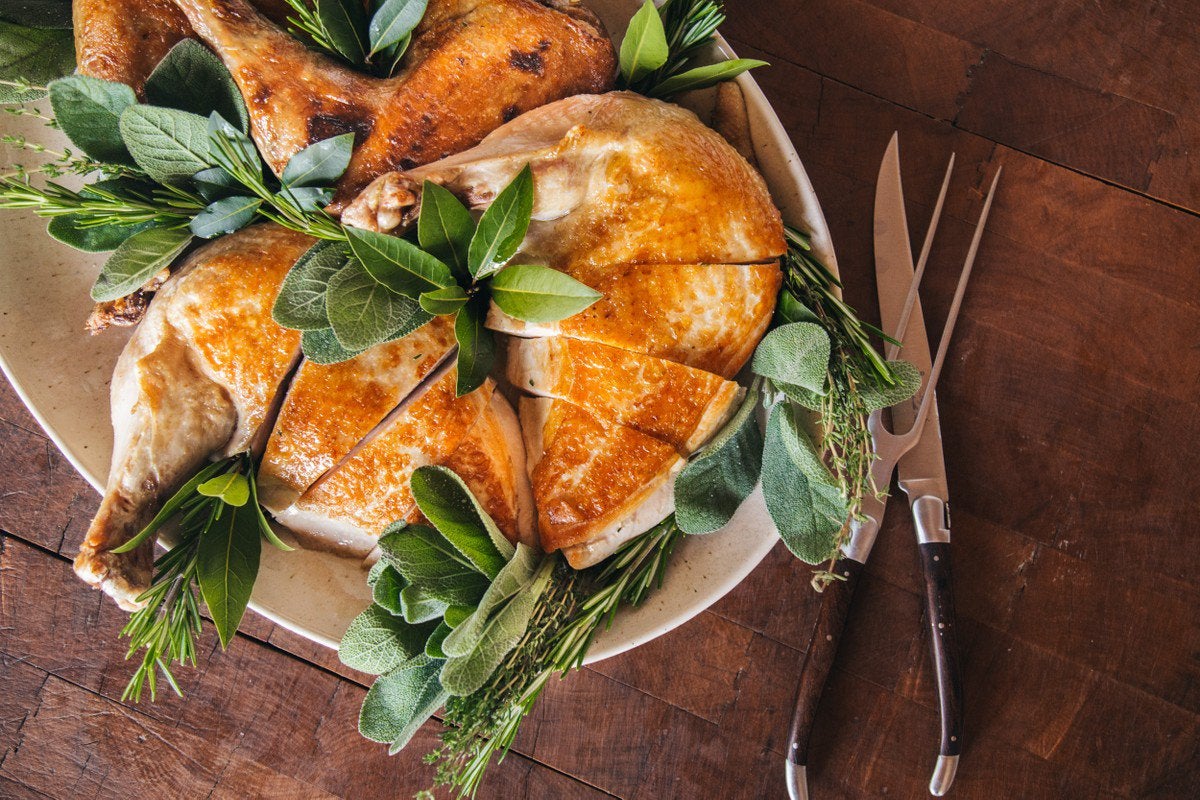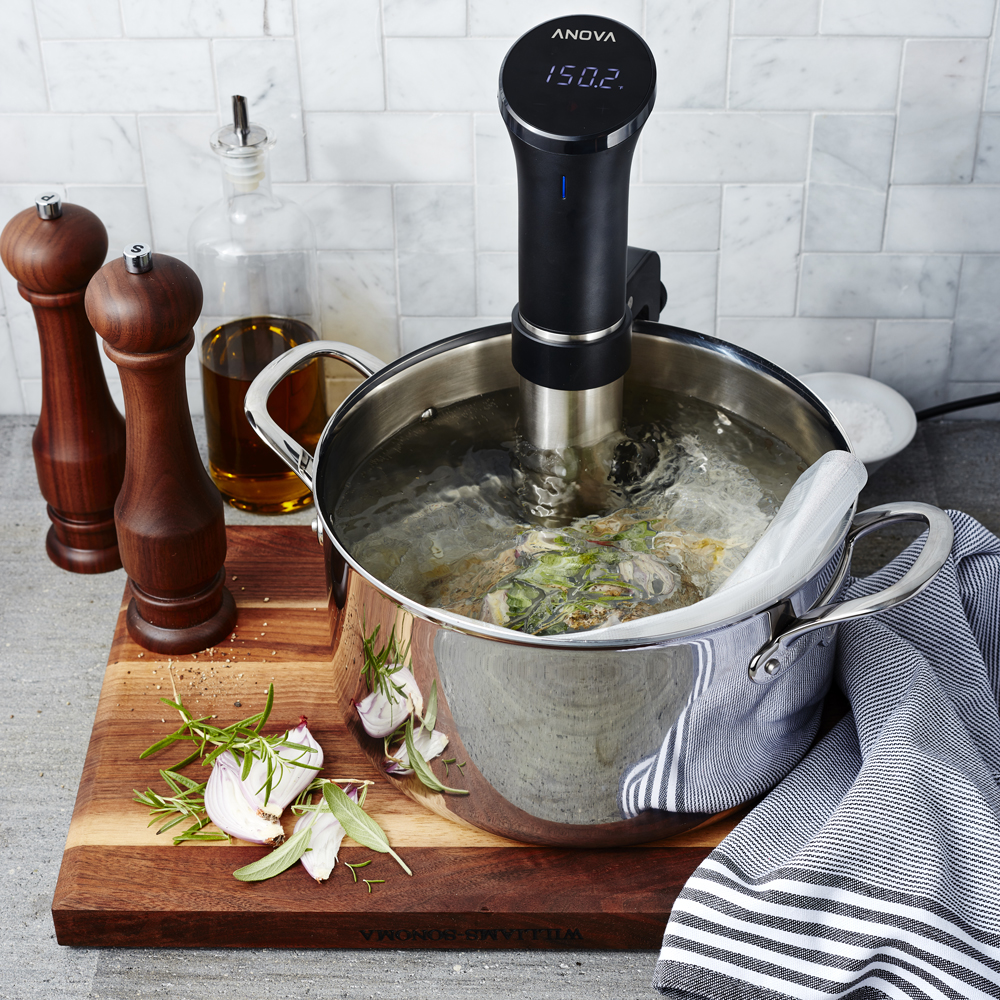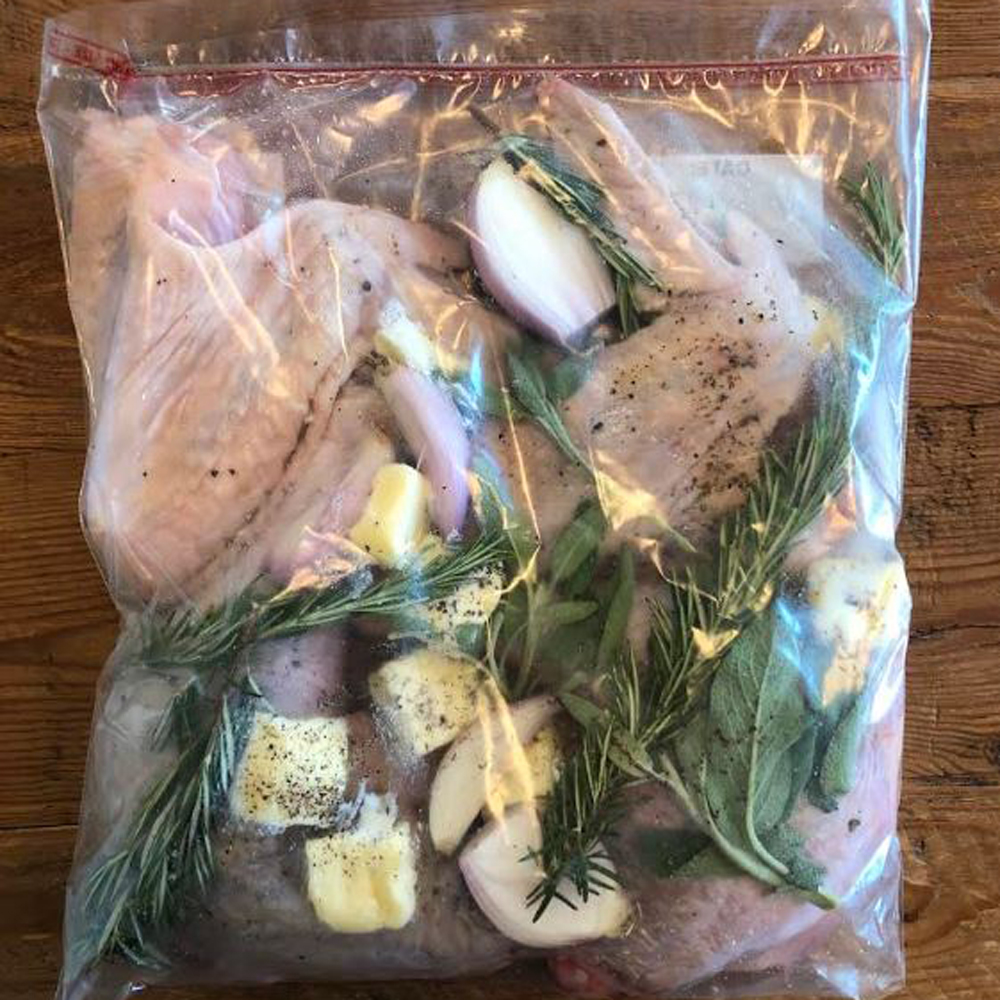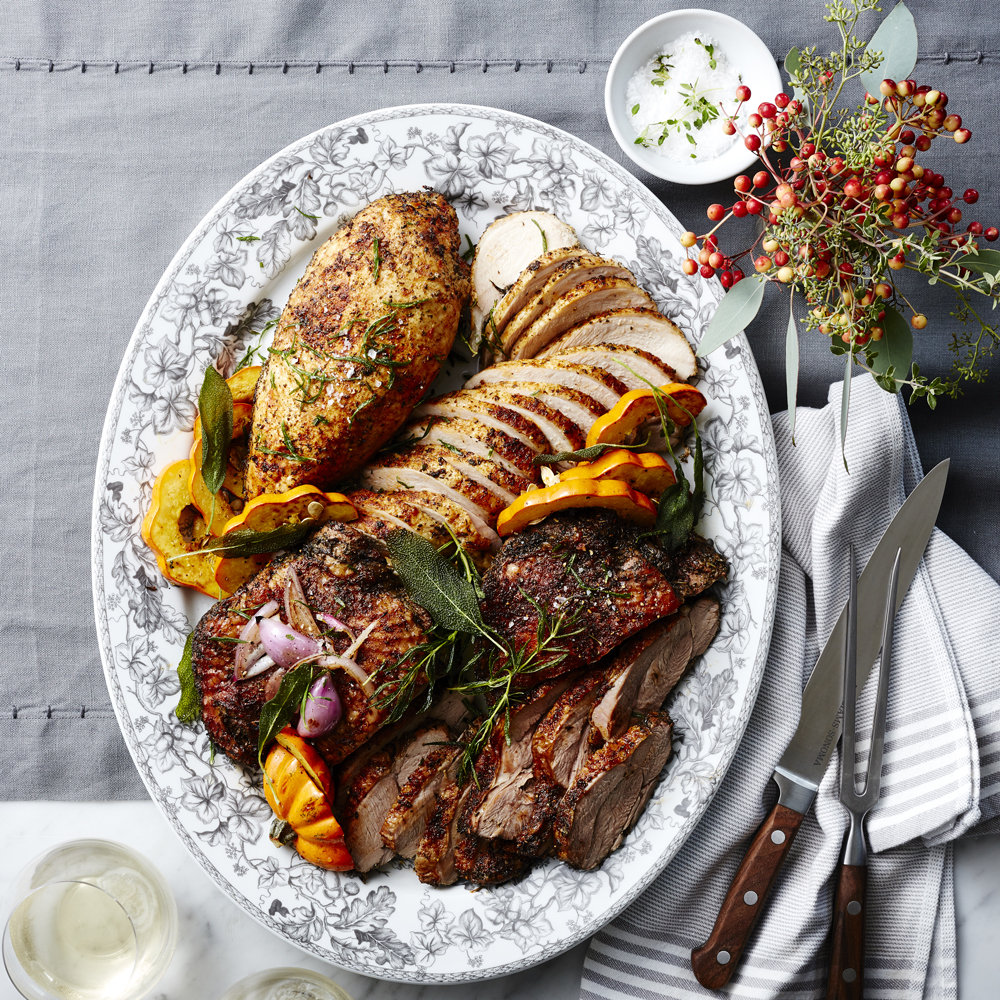
Usually for Thanksgiving our family has a big gathering, but with the pandemic no one wants to get on a plane so it’ll just be my wife and I and our toddler.
This presents the perfect time to experiment with an all (or mostly) sous vide Thanksgiving! Starters, the turkey, the sides, even dessert!
Even if you’re an experienced cook, preparing a Thanksgiving turkey can be a nerve-racking experience. A lot is riding on preparing the perfect bird, and—let’s face it—you probably haven’t roasted a turkey since last Thanksgiving.
As anyone who has suffered through eating a bland, dry turkey knows, it’s all too easy to mess up the centerpiece of the Thanksgiving feast. All of this led the cooks in our Test Kitchen to wonder whether you could use an immersion circulator, also known as a sous vide machine, to cook a turkey.
After several experiments in our Test Kitchen and in our homes, we can safely say not only can you sous vide your Thanksgiving turkey, but you totally should… and this is the best way to do it.
Why You Should Sous Vide a Turkey
Sous viding a turkey resulted in the juiciest bird we’ve ever eaten—perhaps the only one we’ve tasted that didn’t require any gravy to moisten it. And, if that wasn’t enough, the turkey flavor was better, too. We were surprised to discover that the meat had a deeper, more intense and more savory flavor than a roasted turkey.
The sous vide method is also ideal for streamlining Thanksgiving prep. Because you can cook the turkey up to 3 days before the big day, it eliminates the pressure of hoping your bird is cooked through without being overly done. And because it only needs about 25 minutes in the oven right before serving, it also frees up valuable space in your oven in those busy hours right before dinner. (Although the turkey will look pale and, honestly, not that appetizing when it comes out of the vacuum-sealed bags, a short stint in the oven will turn the skin crisp and beautifully browned.)
How Sous Vide Turkey Works
The main reason it’s challenging to roast a turkey to perfection is that the white meat is thoroughly cooked at a lower temperature than dark meat, which means that by the time the thighs are properly cooked, the breast meat is overdone. But by breaking the turkey into parts, dividing the white and dark meat, you can cook them for different amounts of time to precisely the right temperature. And, because the turkey is cooked in a vacuum-sealed bag, where the moisture can’t evaporate, it ends up juicier than you ever imagined it could be, deeply infused with the flavor of the butter and herbs that are sealed in the bag with it.
What You Need to Sous Vide a Turkey

Once found almost exclusively in professional kitchens, immersion circulators are now easily accessible to home cooks, as they have become smaller, easier to use and priced for almost any budget. You’ll also need bags to cook the turkey in. You can use vacuum-sealable bags and a vacuum sealer, if you have them, but for this recipe you can also use 1-gallon zipper-lock bags instead. Finally, you’ll need a very large pot or other heat-safe vessel for the water. We’ve used everything from a 3-gallon stockpot to a 4-gallon lobster pot—we even used a 5-gallon bucket we picked up at the hardware store—and they all worked great.
How to Break Down the Turkey
In order to cook the different parts of the turkey to different temperatures, you’re going to need to break the turkey down into parts before cooking it. If you’ve planned ahead you can ask your butcher to do this for you, but if you haven’t, never fear. With a sharp knife and a little patience, you can do it yourself following these steps.
Set Yourself Up for Success
- Find the sharpest chef’s knife in your kitchen and set a large cutting board on top of a damp paper towel or rubber mat (this will keep it from slipping).
- Remove the giblets and neck from the turkey and set them aside to use in your stock or gravy, if desired.
- Pat the surface and the cavity of your (thoroughly defrosted!) turkey dry with paper towels. The drier your turkey is, the less slippery and easier to handle it will be.
- Place the turkey on the cutting board with the breast side up and the legs pointing toward you.
Remove the Legs and Thighs
- Grab one of the legs, pull it slightly away from the body of the bird and cut through the skin between the leg and the breast until you hit the joint. Repeat with the second leg.
- Press one of the legs down firmly toward the cutting board, which will expose the joint. (You may hear a crack.) Repeat with the second leg.
- Cut through one of the exposed joints until the drumstick and thigh can be separated from the rest of the bird. Repeat with the second leg.
Remove the Wings
- If the wings are tucked under the breast, untuck them so you can see all the joints.
- Cut through the skin between the wing and the breast, carefully guiding your knife around the entire joint. You may have to flip the bird over here to get all around the wing.
- With the turkey breast side up, snap one of the wings toward the cutting board so that the joint is exposed. Cut through the joint until the wing separates from the bird, pulling and twisting the wing if necessary to get the wing to come off. Repeat with the second wing.
Remove the Back
- Set the breast upright on your cutting board, with the cavity side facing up. Guide your knife straight down under the breast, cutting away the ribs and backbone. When you get to where the neck meets the breast, use your knife to work around the joint, then press gently to snap the breast away from the bone. Set aside the backbone for your gravy or stock, if desired.
- Cut off any large flaps of skin and discard.
The Recipe
Sous Vide Turkey
Ingredients
- 1 turkey, 12 to 14 lb. (6 to 7 kg), broken down as described above
- 20 Tbs. (2 1/2 sticks) (10 oz./310 g) unsalted butter, cut into tablespoons, at room temperature
- Kosher salt and freshly ground pepper
- 6 shallots, peeled and halved
- 15 fresh sage sprigs
- 15 fresh rosemary sprigs
- 15 fresh thyme sprigs
Directions
1. Attach an immersion circulator to a very large stockpot or other large heatproof container. Fill the pot with water until it reaches at least 2 inches (5 cm) above the minimum fill line. Using the immersion circulator, preheat the water to 150°F (66°C) according to the manufacturer’s instructions.
2. Arrange the turkey pieces, skin side up, in a single layer on a baking sheet. Working with one piece at a time, gently slide your fingers between the skin and flesh to loosen the skin. Using half of the butter (10 Tbs./5 oz./155 g), rub the butter under the skin of the turkey. Season both sides of each piece of turkey generously with salt.
3. Place the breast in a vacuum-sealable bag or in a 1-gallon zipper-lock bag. Add 4 Tbs. (1/2 stick/2 oz./60 g) of the remaining butter, 4 of the shallot halves and 5 each of the sage, rosemary and thyme sprigs to the bag. Set aside.
4. Place both legs and both wings in a single layer in a separate vacuum-sealable bag or in a 1-gallon zipper-lock bag. (If they won’t fit, you can put them in two separate bags and divide the remaining ingredients between the two bags.) Add the remaining 6 Tbs. (3/4 stick/3 oz./90 g) butter, the remaining 8 shallot halves and the remaining 10 sage, rosemary and thyme sprigs.

5. If using vacuum-sealable bags, vacuum and seal the bags according to the manufacturer’s instructions. If using zipper-lock bags, fill a large pot or bowl with room-temperature water. Working with one bag at a time, lower the bag into the water. The water pressure will force the excess air out of the bag. When the top of the bag reaches the level of the water, seal the bag tightly.
6. Submerge the sealed bags in the circulating water. Cook the breasts for 4 hours, then remove from the water and transfer to an ice bath until chilled. (Leave the legs and wings in the water bath.) When the breast is chilled, transfer to the refrigerator for up to 3 days. Continue cooking the legs and wings in the water bath for 3 hours more, then transfer to an ice bath until chilled. When chilled, transfer to the refrigerator for up to 3 days.
7. When ready to serve, preheat an oven to 450°F (230°C).
8. Remove the turkey pieces from the bags discard the shallots and herbs. Place the breast on one baking sheet and the legs and wings on another baking sheet in a single layer. Discard the shallots and herbs. Season the turkey pieces lightly with salt and pepper.
9. Transfer to the oven and roast until the skin is deep golden brown and an instant-read thermometer inserted into the breast registers 165°F (74°C) and into the thighs registers 175°F (80°C), about 25 minutes. Remove the oven and let rest for 10 to 20 minutes before carving. Serves 10.


Dining and Cooking